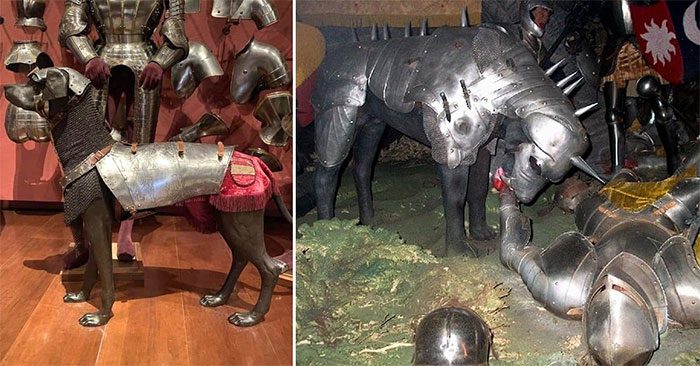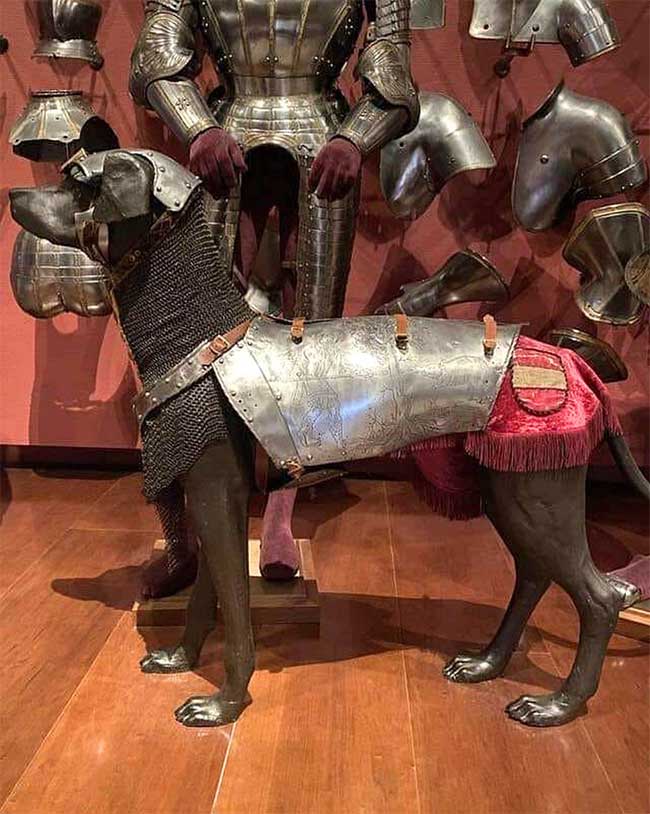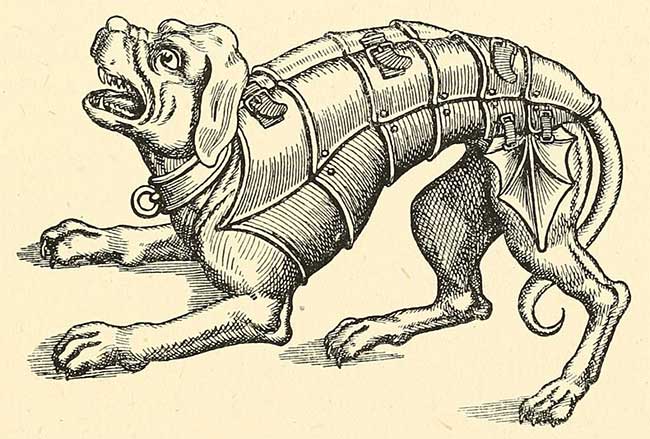From battlefields to royal palaces, medieval dog armor is considered a fascinating relic of a bygone era, offering profound insights into the unique bond between humans and their loyal canine companions.

Dogs have a long history of participating in wars, likely dating back to ancient times. From being trained for combat to serving as scouts, guards, messengers, search and rescue dogs, and trackers, their uses are diverse, with some continuing in modern military applications.
In the Great Hall of the Royal Armory at the Royal Palace in Madrid, there is a peculiar artifact – a meticulously crafted set of armor, not for a brave human knight, but for man’s faithful companion – the dog. This 16th-century masterpiece, created by the renowned Desiderius Helmschmid between 1530 and 1540, ignites our imagination and raises the question: why would a dog need armor?
In fact, the practice of dogs wearing armor was not uncommon among the European nobility during this time. These “armored dogs” were used for hunting, protection, and even as instruments of war; these canine warriors were seen as symbols of status and fierce guardians.

Dog armor from the court of Charles V displayed at the Royal Armory of Madrid.
This special set of armor discovered from the arsenal of Holy Roman Emperor Charles V (1500–1558) is a unique example, thanks to its metal components and the protective lining underneath. Perhaps created for a beloved dog of the emperor, the decorative engraving on this armor depicts a hunter poised to attack a boar charging forward, indicating that it was designed for hunting this particular animal.
Helmschmid’s masterpiece, crafted from engraved steel and gilded, is a marvel both functionally and artistically. Each component – the breastplate, the flanks, even the tiny helmet – is meticulously designed to fit the dog’s anatomy, providing protection without hindering movement.
For the Greeks and Romans, dogs were often used as guards or patrols, although they were sometimes brought into battle. The earliest recorded use of war dogs in battle is attributed to Alyattes of Lydia against the Cimmerians around 600 BC. Lydian dogs killed several invaders and drove off others.
Beyond its historical significance and artistic value, this dog armor “tells” stories of a time long past. It speaks to the deep bond between humans and animals, the trust placed in these furry companions, and the lengths humans have gone to ensure their safety.

In ancient times, dogs, often large breeds, would be outfitted with armor or spiked collars and sent into battle to attack enemies. This strategy was employed by various civilizations, including the Romans and Greeks. While not as common as in previous centuries, modern armies still utilize dogs in attack roles.
The use of medieval dog armor was not limited to the court of Charles V – it was produced throughout Europe from the 14th to the 16th centuries. Dog armor was typically made from leather, steel, or even boiled wood, serving practical purposes such as hunting, guarding, and even warfare. It protected valuable hunting dogs from bites and claws, bolstering the courage of smaller breeds and instilling fear in enemies.

While some are simple leather coats, others are intricate works of art, adorned with engravings, jewelry, and even helmets, reflecting the wealth and status of their owners.
But where did the medieval tradition of using armor for dogs originate? For instance, did the ancient Romans use them? There is no compelling evidence that the Romans used dog-specific armor. However, we can be certain that ancient Romans did use dogs for tasks such as hunting, herding, and guarding. Historical sources and archaeological findings primarily refer to protective collars and spiked metal gear, often focusing on preventing attacks from wolves and other predators rather than complete suits of armor.

The use of dog armor significantly declined after the medieval period.
So what happened after the medieval period? (The exact end date of the Middle Ages is still debated, and the dog armor from the court of Charles V can be seen as marking the end of the medieval era). Did the arming of dogs continue?
Although the use of dog armor significantly declined after the medieval period, this practice did not disappear entirely. Dog armor continued to be used, primarily for hunting and protection, although it was less complex and decorative than in the medieval era. Designs were adjusted to accommodate advancements in firearms, often focusing on protecting vital areas such as the chest and abdomen.


















































